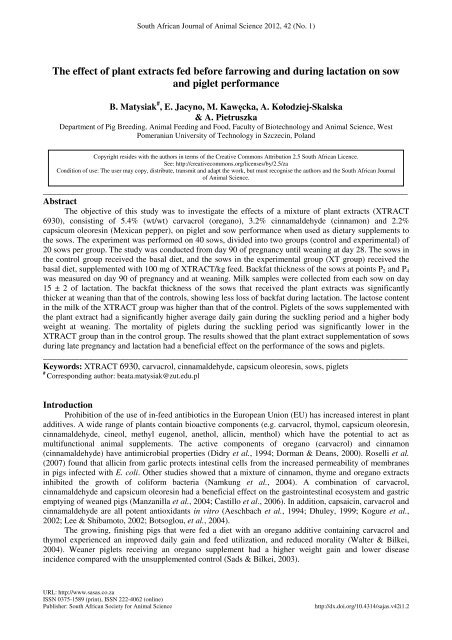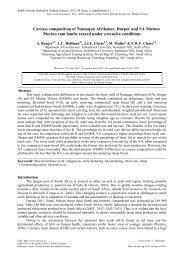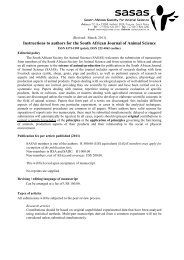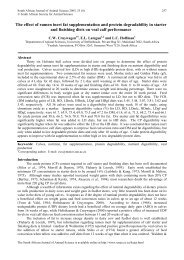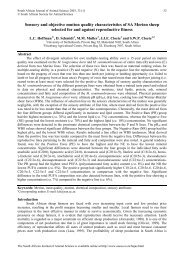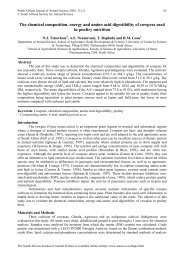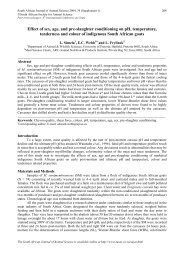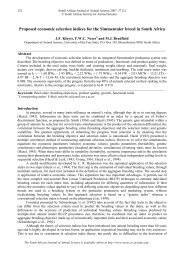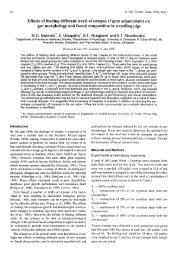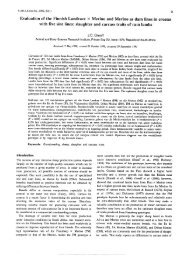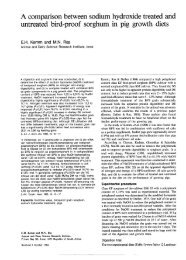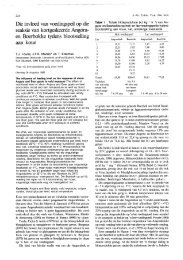The effect of plant extracts fed before farrowing and during lactation ...
The effect of plant extracts fed before farrowing and during lactation ...
The effect of plant extracts fed before farrowing and during lactation ...
You also want an ePaper? Increase the reach of your titles
YUMPU automatically turns print PDFs into web optimized ePapers that Google loves.
South African Journal <strong>of</strong> Animal Science 2012, 42 (No. 1)<strong>The</strong> <strong>effect</strong> <strong>of</strong> <strong>plant</strong> <strong>extracts</strong> <strong>fed</strong> <strong>before</strong> <strong>farrowing</strong> <strong>and</strong> <strong>during</strong> <strong>lactation</strong> on sow<strong>and</strong> piglet performanceB. Matysiak # , E. Jacyno, M. Kawęcka, A. Kołodziej-Skalska& A. PietruszkaDepartment <strong>of</strong> Pig Breeding, Animal Feeding <strong>and</strong> Food, Faculty <strong>of</strong> Biotechnology <strong>and</strong> Animal Science, WestPomeranian University <strong>of</strong> Technology in Szczecin, Pol<strong>and</strong>Copyright resides with the authors in terms <strong>of</strong> the Creative Commons Attribution 2.5 South African Licence.See: http://creativecommons.org/licenses/by/2.5/zaCondition <strong>of</strong> use: <strong>The</strong> user may copy, distribute, transmit <strong>and</strong> adapt the work, but must recognise the authors <strong>and</strong> the South African Journal<strong>of</strong> Animal Science.________________________________________________________________________________Abstract<strong>The</strong> objective <strong>of</strong> this study was to investigate the <strong>effect</strong>s <strong>of</strong> a mixture <strong>of</strong> <strong>plant</strong> <strong>extracts</strong> (XTRACT6930), consisting <strong>of</strong> 5.4% (wt/wt) carvacrol (oregano), 3.2% cinnamaldehyde (cinnamon) <strong>and</strong> 2.2%capsicum oleoresin (Mexican pepper), on piglet <strong>and</strong> sow performance when used as dietary supplements tothe sows. <strong>The</strong> experiment was performed on 40 sows, divided into two groups (control <strong>and</strong> experimental) <strong>of</strong>20 sows per group. <strong>The</strong> study was conducted from day 90 <strong>of</strong> pregnancy until weaning at day 28. <strong>The</strong> sows inthe control group received the basal diet, <strong>and</strong> the sows in the experimental group (XT group) received thebasal diet, supplemented with 100 mg <strong>of</strong> XTRACT/kg feed. Backfat thickness <strong>of</strong> the sows at points P 2 <strong>and</strong> P 4was measured on day 90 <strong>of</strong> pregnancy <strong>and</strong> at weaning. Milk samples were collected from each sow on day15 ± 2 <strong>of</strong> <strong>lactation</strong>. <strong>The</strong> backfat thickness <strong>of</strong> the sows that received the <strong>plant</strong> <strong>extracts</strong> was significantlythicker at weaning than that <strong>of</strong> the controls, showing less loss <strong>of</strong> backfat <strong>during</strong> <strong>lactation</strong>. <strong>The</strong> lactose contentin the milk <strong>of</strong> the XTRACT group was higher than that <strong>of</strong> the control. Piglets <strong>of</strong> the sows supplemented withthe <strong>plant</strong> extract had a significantly higher average daily gain <strong>during</strong> the suckling period <strong>and</strong> a higher bodyweight at weaning. <strong>The</strong> mortality <strong>of</strong> piglets <strong>during</strong> the suckling period was significantly lower in theXTRACT group than in the control group. <strong>The</strong> results showed that the <strong>plant</strong> extract supplementation <strong>of</strong> sows<strong>during</strong> late pregnancy <strong>and</strong> <strong>lactation</strong> had a beneficial <strong>effect</strong> on the performance <strong>of</strong> the sows <strong>and</strong> piglets.________________________________________________________________________________Keywords: XTRACT 6930, carvacrol, cinnamaldehyde, capsicum oleoresin, sows, piglets#Corresponding author: beata.matysiak@zut.edu.plIntroductionProhibition <strong>of</strong> the use <strong>of</strong> in-feed antibiotics in the European Union (EU) has increased interest in <strong>plant</strong>additives. A wide range <strong>of</strong> <strong>plant</strong>s contain bioactive components (e.g. carvacrol, thymol, capsicum oleoresin,cinnamaldehyde, cineol, methyl eugenol, anethol, allicin, menthol) which have the potential to act asmultifunctional animal supplements. <strong>The</strong> active components <strong>of</strong> oregano (carvacrol) <strong>and</strong> cinnamon(cinnamaldehyde) have antimicrobial properties (Didry et al., 1994; Dorman & Deans, 2000). Roselli et al.(2007) found that allicin from garlic protects intestinal cells from the increased permeability <strong>of</strong> membranesin pigs infected with E. coli. Other studies showed that a mixture <strong>of</strong> cinnamon, thyme <strong>and</strong> oregano <strong>extracts</strong>inhibited the growth <strong>of</strong> coliform bacteria (Namkung et al., 2004). A combination <strong>of</strong> carvacrol,cinnamaldehyde <strong>and</strong> capsicum oleoresin had a beneficial <strong>effect</strong> on the gastrointestinal ecosystem <strong>and</strong> gastricemptying <strong>of</strong> weaned pigs (Manzanilla et al., 2004; Castillo et al., 2006). In addition, capsaicin, carvacrol <strong>and</strong>cinnamaldehyde are all potent antioxidants in vitro (Aeschbach et al., 1994; Dhuley, 1999; Kogure et al.,2002; Lee & Shibamoto, 2002; Botsoglou, et al., 2004).<strong>The</strong> growing, finishing pigs that were <strong>fed</strong> a diet with an oregano additive containing carvacrol <strong>and</strong>thymol experienced an improved daily gain <strong>and</strong> feed utilization, <strong>and</strong> reduced morality (Walter & Bilkei,2004). Weaner piglets receiving an oregano supplement had a higher weight gain <strong>and</strong> lower diseaseincidence compared with the unsupplemented control (Sads & Bilkei, 2003).URL: http://www.sasas.co.zaISSN 0375-1589 (print), ISSN 222-4062 (online)Publisher: South African Society for Animal Sciencehttp://dx.doi.org/10.4314/sajas.v42i1.2
16Matysiak et al., 2012. S. Afr. J. Anim. Sci. vol. 42Plant <strong>extracts</strong>, therefore, may present an opportunity to enhance lactating sow <strong>and</strong> litter performancewhen used as dietary supplements. Added to the pre-<strong>farrowing</strong> <strong>and</strong> <strong>lactation</strong> diets <strong>of</strong> sows, oregano reducesthe sow mortality rate <strong>and</strong> culling rate <strong>during</strong> <strong>lactation</strong>, <strong>and</strong> increases the <strong>farrowing</strong> rate <strong>and</strong> piglet health(Allan & Bilkei, 2005). Khajarern <strong>and</strong> Khajarern (2002) reported an increased daily feed intake in lactatingsows when oregano was added to their diet. In addition, daily weight gain was higher in pre-weaned pigsfrom those sows than in litters from sows not receiving oregano. <strong>The</strong> addition <strong>of</strong> a <strong>plant</strong> extract mixturecontaining carvacrol, cinnamaldehyde <strong>and</strong> capsicum to the <strong>lactation</strong> diets <strong>of</strong> sows improved nutrientdigestibility <strong>and</strong> piglet performance prior to weaning (Ilsley et al., 2003).In this study the <strong>effect</strong>s were evaluated <strong>of</strong> a mixture <strong>of</strong> <strong>plant</strong> <strong>extracts</strong> containing carvacrol (oregano),cinnamaldehyde (cinnamon) <strong>and</strong> capsicum oleoresin (Mexican pepper), on the backfat thickness <strong>of</strong> sows<strong>during</strong> <strong>lactation</strong>, the milk composition <strong>of</strong> the sows, <strong>and</strong> piglet performance <strong>during</strong> suckling.Materials <strong>and</strong> Methods<strong>The</strong> study was carried out <strong>during</strong> the summer at a commercial farm on 200 sows (West PomeranianRegion, Pol<strong>and</strong>, EU). Forty multiparous, hybrid sows (Polish L<strong>and</strong>race x Polish Large White) wereartificially inseminated with sperm from Pietrain x Duroc boars. On day 90 <strong>of</strong> pregnancy, 40 sows wereassigned by the analogue method (body weight <strong>and</strong> parity) to two experimental groups <strong>of</strong> 20 pigs each, theTable 1 Ingredient composition <strong>and</strong> nutritive value diets (as <strong>fed</strong> basis) 1IngredientComponent (g/kg feed)Barley 230.5Wheat 300.0Naked oats 150.0Maize 100.0Wheat bran 60.0Soybean meal (47% CP) 125.0Dicalcium phosphate 2.5Premix 2 30.0Acidificator 3 2.0NutrientsMetabolizable energy, MJ/kg 4 13.2Crude protein, g/kg 179.0Crude fibre, g/kg 39.6Lysine, g/kg 8.8Methionine + cystine, g/kg 6.1Threonine, g/kg 6.0Tryptophan, g/kg 1.9Calcium, g/kg 8.2Phosphorus, g/kg 7.61Experimental diet was supplemented with 100 mg XTRACT 6930 per kg <strong>of</strong> feed.2Provided the following per kg <strong>of</strong> diet: 90 mg Mn; 99 mg Zn; 18 mg Cu; 1.5 mg I; 0.4 mg Se; 120 mg Fe;0.3 g Mg; 6.9 g Ca; 1.7 g P; 15000 IU vitamin A; 1800 IU vitamin D 3 ; 60 mg vitamin E; 2.25 mg vitamin K; 6mg vitamin B 2 ; 2.4 mg vitamin B 6 ; 30 µg vitamin B 12 ; 60 mg biotin; 1.5 mg folic acid; 0.45 g choline chloride;6 mg pantothenic acid; 1.5 g lysine.3Acidificator – lactic acid, formic acid.4Calculated from Polish Norm <strong>of</strong> Pig Nutrition (1993).
Matysiak et al., 2012. S. Afr. J. Anim. Sci. vol. 42 17control <strong>and</strong> the supplemented group. <strong>The</strong> sows were housed in individual <strong>farrowing</strong> pens (2.20 x 1.80 m).<strong>The</strong> <strong>farrowing</strong> pens had a partially slatted floor with a separate piglet creep area, maintained at a hightemperature with a heat lamp. <strong>The</strong> piglets were suckled for 27 days <strong>and</strong> weaned on day 28 <strong>of</strong> <strong>lactation</strong>. Fromday 90 <strong>of</strong> pregnancy until weaning at day 28, the sows in the control group were <strong>fed</strong> on the basal diet (Table1), <strong>and</strong> the sows in the experimental group (XT group) on the basal diet supplemented with 100 mgXTRACT 6930/kg (PANCOSMA co. Switzerl<strong>and</strong>). <strong>The</strong> XTRACT consists <strong>of</strong> 5.4% (wt/wt) carvacrol(Origanum spp.), 3.2% cinnamaldehyde (Cinnamomum spp.) <strong>and</strong> 2.2% capsicum oleoresin (Capsicumannum).From day 90 to 110 <strong>of</strong> pregnancy, the sows were <strong>fed</strong> 3.0 kg/day <strong>and</strong> from day 111 to <strong>farrowing</strong>, 2.0kg/day. After <strong>farrowing</strong>, the sows were <strong>fed</strong> 1.5 kg <strong>of</strong> diet, which was increased to 2 kg at day 4. From day 5<strong>of</strong> <strong>lactation</strong> up to weaning, the diet was <strong>of</strong>fered ad libitum (average 6.2 kg/head). Water was provided bynipple drinkers.<strong>The</strong> piglets were <strong>of</strong>fered a creep feed from day 10 <strong>of</strong> age until weaning. <strong>The</strong> creep feed <strong>of</strong> the pigletscontained (per kg) 15.5 MJ metabolizable energy, 210 g crude protein, 72 g crude fat, 25 g crude fibre, 13 glysine, 4 g methionine. <strong>The</strong> basal diet contained 40% wheat, 30% barley, 20% soybean <strong>and</strong> 10% Suggi(mineral-vitamin mixture).Backfat thickness at points P 2 <strong>and</strong> P 4 (3 cm <strong>and</strong> 8 cm respectively from the back midline behind thelast rib) was measured on day 90 <strong>of</strong> pregnancy <strong>and</strong> at weaning. Backfat thickness was measured with anultrasonic apparatus (Piglog 105; SFK-Technology, Denmark).Approximately 15 mL <strong>of</strong> milk was collected from each sow on day 15 ± 2 <strong>of</strong> <strong>lactation</strong> to evaluate thecomposition <strong>of</strong> the milk. <strong>The</strong> milk samples were collected after an intramuscular injection <strong>of</strong> 20 IU <strong>of</strong>oxytocin <strong>and</strong> manual milking <strong>of</strong> the third <strong>and</strong> fourth anterior mammary gl<strong>and</strong>s on one side <strong>of</strong> the sow. Milksamples were frozen (-20 °C) immediately, pending analysis. <strong>The</strong> number <strong>of</strong> piglets born (total: number bornalive <strong>and</strong> number stillborn) was recorded. Six hours after birth, the piglets were weighed separately <strong>and</strong> eartaggedfor individual identification. Individual piglets were weighed at day 21 <strong>and</strong> at weaning on day 28 <strong>of</strong>age. Piglet mortality from birth to weaning was recorded.<strong>The</strong> chemical composition in the diet was determined by st<strong>and</strong>ard methods (AOAC, 1995), whileamino acids in the diet were assayed with the Beckman automatic analyser. Phosphorus (P) was assayed bythe vanadium-molybdenum photocolorimetric method, <strong>and</strong> calcium (Ca) was checked by the emissionspectrometry method on a Buck Scientific Spectrophotometer. <strong>The</strong> basic composition <strong>of</strong> the milk (drymatter, fat, protein <strong>and</strong> lactose) was determined by using an infrared milk analyser (Milko-Scan 133-BAnalyser, Foss Electric, Hillerød, Denmark).Conventional statistical methods were used to calculate means <strong>and</strong> st<strong>and</strong>ard error <strong>of</strong> the mean. Toascertain a significant difference between the levels <strong>of</strong> the main factor, the t-test was applied between means.For features which do not have a normal distribution, a nonparametric test U Mann-Whitney was applied.Statistical data analysis was undertaken using the STATISTICA PL Version 8.0 statistical package.ResultsSows supplemented with the <strong>plant</strong> extract mixture had a higher backfat thickness at weaning (at pointsP 2 – P
18Matysiak et al., 2012. S. Afr. J. Anim. Sci. vol. 42Table 2 Effect <strong>of</strong> including <strong>plant</strong> extract mixture (XT) in the diet <strong>of</strong> sows on their backfat thickness <strong>and</strong> milkcompositionItemControlGroups 1XTSEMNo. <strong>of</strong> sows 20 20Backfat thickness (mm)d 90 <strong>of</strong> gestationat P2 16.2 16.8 0.89at P4 15.7 16.2 0.85Weaningat P2 13.7 a 15.6 b** 0.87at P4 13.3 14.6 * 0.85Changeat P2 -2.4 a -1.3 b** 0.36at P4 -2.3 a -1.6 b** 0.28Milk composition (%)Dry matter 16.19 16.21 0.43Fat 6.49 6.19 0.64Protein 4.20 4.14 0.31Lactose 5.00 a 5.82 b** 0.11Mean values within the same row with different superscripts differ significantly.*At P
Matysiak et al., 2012. S. Afr. J. Anim. Sci. vol. 42 19Table 4 Effect <strong>of</strong> including <strong>plant</strong> extract mixture (XT) in the diet <strong>of</strong> sows on the weight <strong>of</strong> the piglets <strong>and</strong>litters <strong>and</strong> average daily gain <strong>of</strong> pigletsItemControlGroups*XTSEMNo. <strong>of</strong> litters 20 20Litters weight (kg)Birth 15.3 14.7 0.41Weaning 65.7 a 76.0 b 1.12Body weight <strong>of</strong> piglets (kg)Birth 1.42 1.36 0.09Day 21 5.23 5.38 0.19Weaning 6.65 a 7.34 b 0.22Average daily gain <strong>of</strong> piglets from birth (g):to 21 days 189 201 5.10to weaning 194 a 220 b 6.20* Within rows, means with different superscripts are significantly different at P
20Matysiak et al., 2012. S. Afr. J. Anim. Sci. vol. 42ReferencesAeschbach, K., Loliger, J., Scott, B.C., Murcia, A., Butler, J., Halliwell, B. & Aruoma, O.I., 1994.Antioxidant actions <strong>of</strong> thymol, carvacrol, 6-gingerol, zingerone <strong>and</strong> hydroxytyrosol. Food Chem.Toxicol. 32, 31-36.Allan, P. & Bilkei, G., 2005. Oregano improves reproductive performance <strong>of</strong> sows. <strong>The</strong>riogenology 63,716-721.Ando, S., Nishida, T., Ishida, I., Kochi, Y., Kami, A. & Se, S., 2001. Transmission <strong>of</strong> herb essential oil tomilk <strong>and</strong> change <strong>of</strong> milk flavour by feeding dried herbs to lactating Holstein Friesian cows. J. JPNSoc. Food Sci. 48, 142-145.AOAC, 1995. Official Methods <strong>of</strong> Analysis (16th ed.). Association <strong>of</strong> Official Analytical Chemists, Inc.,Arlington, Virginia, USA.Azumi, S., Tanimura, A. & Tanamoto, K., 1997. A novel inhibitor <strong>of</strong> bacterial endotoxin derived fromcinnamon bark. Biochem. Biophys. Res. Commun. 234, 506-510.Botsoglou, N.A., Christaki, E., Florou-Paneri, P., Giannenas, I., Papageorgiou, G. & Spais, A.B., 2004. <strong>The</strong><strong>effect</strong> <strong>of</strong> a mixture <strong>of</strong> herbal essential oils or α-tocopheryl acetate on performance parameters <strong>and</strong>oxidation <strong>of</strong> body lipid in broilers. S. Afr. J. Anim. Sci. 34, 52-61.Castillo, M., Martin-Orue, S.M., Roca, M., Manzanilla, E.G., Badiola, I., Perez, J.F. & Gasa, J., 2006. <strong>The</strong>response <strong>of</strong> gastrointestinal microbiota to avilamycin, butyrate, <strong>and</strong> <strong>plant</strong> <strong>extracts</strong> in early-weanedpigs. J. Anim. Sci. 84, 2725-2734.Dhuley, J.N., 1999. Antioxidant <strong>effect</strong>s <strong>of</strong> cinnamon (Cinnamomum verum) bark <strong>and</strong> greater cardamom(Amomum sibulatum) seeds in rats <strong>fed</strong> high fat diet. Indian J. Exp. Biol. 37, 238-242.Didry, N., Dubreuil, L. & Pinkas, M., 1994. Activity <strong>of</strong> thymol, carvacrol, cinnamaldehyde <strong>and</strong> eugenol onoral bacteria. Pharm. Acta Helv. 69, 25-28.Dorman, H.J. & Deans, S.G., 2000. Antimicrobial agents from <strong>plant</strong>s: Antibacterial activity <strong>of</strong> <strong>plant</strong> volatileoils. J. Appl. Microbiol. 8, 308-316.Ilsley, S.E., Miller, H.M., Greathead, H.M.R. & Kamel, C., 2003. Plant <strong>extracts</strong> as supplements for lactatingsows: <strong>effect</strong>s on piglet performance, sow food intake <strong>and</strong> diet digestibility. Anim. Sci. 77, 247-254.Khajarern, J. & Khajarern, S., 2002. <strong>The</strong> efficacy <strong>of</strong> origanum essential oils in sows feed. Int. Pig Topics 17,17.Kogure, K., Goto, S., Nishimura, M., Yasumoto, M., Abe, K., Ohiwa, C., Sassa, H., Kusumi, T. & Terada,H., 2002. Mechanism <strong>of</strong> potent antiperoxidative <strong>effect</strong> <strong>of</strong> capsaicin. Biochim. Biophys. Acta 1573,84-92.Kuhn, G., Ender, K., Thomann, R., Tuchscherer, M., Tuchscherer, A., Stabenow, B., Krüger, M. & Schrödl,W., 2005. Application <strong>of</strong> Echinacea - extract in pregnant <strong>and</strong> suckled sows. Arch. Tierz. 48, 270-282[in German].Lee, K.G. & Shibamoto, T., 2002. Determination <strong>of</strong> antioxidant potential <strong>of</strong> volatile <strong>extracts</strong> isolated fromvarious herbs <strong>and</strong> spices. J. Agric. Food Chem. 50, 4947-4952.Manzanilla, E.G., Perez, J.F., Martin, M., Kamel, C., Baucells, F. & Gasa, J., 2004. Effect <strong>of</strong> <strong>plant</strong> <strong>extracts</strong><strong>and</strong> formic acid on the intestinal equilibrium <strong>of</strong> early-weaned pigs. Anim. Sci. 82, 3210-3218.Miller, H.M., 2003. Effects <strong>of</strong> sow <strong>and</strong> piglet dietary supplementation with a <strong>plant</strong> extract additive on thecomposition <strong>of</strong> sow colostrums <strong>and</strong> milk (day 21) <strong>and</strong> its <strong>effect</strong>s on piglet development from birth today 6 postweaning. Final Year Project, Alex Moore 27/3/2003.Namkung, H., Li, M., Gong, J., Yu, H., Cottrill, M. & de Lange, C.F.M., 2004. Impact <strong>of</strong> feeding blends <strong>of</strong>organic acids <strong>and</strong> herbal <strong>extracts</strong> on growth performance, gut microbiota <strong>and</strong> digestive function innewly weaned pigs. Can. J. Anim. Sci. 84, 697-704.Nualart, H., Kamel, C., Gasa, J. & Baucells, F., 2000. Effects on faecal digestibility <strong>of</strong> the inclusion <strong>of</strong>a formulation <strong>of</strong> natural <strong>plant</strong> <strong>extracts</strong> on a post weaning pig diet from 5 to 15 kg. Proc. EAAP. 2000,p. 43.Polish Norm <strong>of</strong> Pig Nutrition, 1993. Institute <strong>of</strong> Animal Physiology <strong>and</strong> Nutrition. Omnitech Press, Warsaw.1-87.Roselli, M., Britti, M.S., Le, Huërou-Luron, I., Marfaing, H., Zhu, W.Y. & Mengheri, E., 2007. Effect <strong>of</strong>different <strong>plant</strong> <strong>extracts</strong> <strong>and</strong> natural substances (PENS) against membrane damage induced byenterotoxigenic Escherichia coli K88 in pig intestinal cells. Toxicol. in Vitro 21, 224-229.
Matysiak et al., 2012. S. Afr. J. Anim. Sci. vol. 42 21Sads, P.R. & Bilkei, G., 2003. <strong>The</strong> <strong>effect</strong> <strong>of</strong> oregano <strong>and</strong> vaccination against Glasser’s disease <strong>and</strong>pathogenic Escherichia coli on postweaning performance <strong>of</strong> pigs. Ir. Vet. J. 56, 611-615.Walter, B.M. & Bilkei, G., 2004. Immunostimulatory <strong>effect</strong> <strong>of</strong> dietary oregano etheric oils on lymphocytesfrom growth-retarded, low-weight growing-finishing pigs <strong>and</strong> productivity. Tijdschr. Diergeneesk.129, 178-181.Zigger, D., 2001. Healthier pigs on diet with garlic <strong>and</strong> cinnamon. Feed Technol. 5 (8/9), 17.


